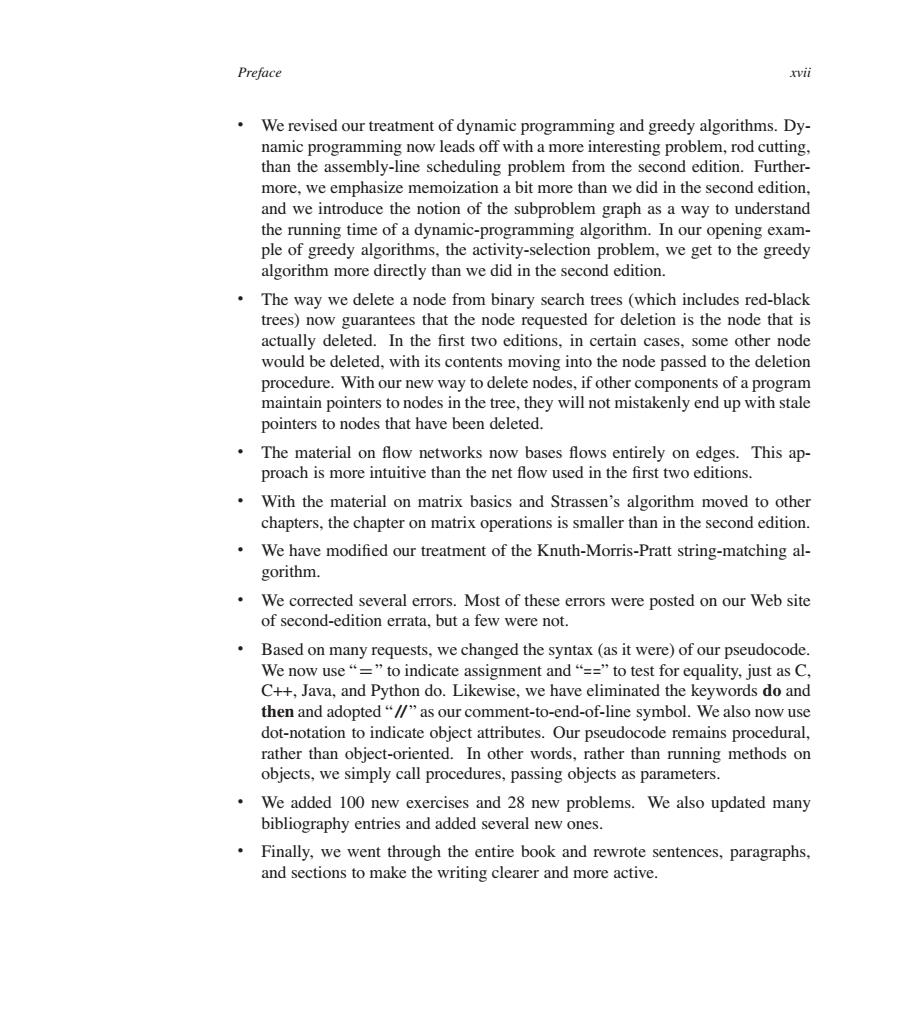正在加载图片...

Preface xvii We revised our treatment of dynamic programming and greedy algorithms.Dy- namic programming now leads off with a more interesting problem,rod cutting, than the assembly-line scheduling problem from the second edition.Further- more,we emphasize memoization a bit more than we did in the second edition, and we introduce the notion of the subproblem graph as a way to understand the running time of a dynamic-programming algorithm.In our opening exam- ple of greedy algorithms,the activity-selection problem,we get to the greedy algorithm more directly than we did in the second edition. 。 The way we delete a node from binary search trees (which includes red-black trees)now guarantees that the node requested for deletion is the node that is actually deleted.In the first two editions,in certain cases,some other node would be deleted,with its contents moving into the node passed to the deletion procedure.With our new way to delete nodes,if other components of a program maintain pointers to nodes in the tree,they will not mistakenly end up with stale pointers to nodes that have been deleted. The material on flow networks now bases flows entirely on edges.This ap- proach is more intuitive than the net flow used in the first two editions. With the material on matrix basics and Strassen's algorithm moved to other chapters,the chapter on matrix operations is smaller than in the second edition. We have modified our treatment of the Knuth-Morris-Pratt string-matching al- gorithm. We corrected several errors.Most of these errors were posted on our Web site of second-edition errata,but a few were not. Based on many requests,we changed the syntax (as it were)of our pseudocode. We now use“=”to indicate assignment and“=”to test for equality,just as C, C++,Java,and Python do.Likewise,we have eliminated the keywords do and then and adopted"//"as our comment-to-end-of-line symbol.We also now use dot-notation to indicate object attributes.Our pseudocode remains procedural, rather than object-oriented.In other words,rather than running methods on objects,we simply call procedures,passing objects as parameters. We added 100 new exercises and 28 new problems.We also updated many bibliography entries and added several new ones. Finally,we went through the entire book and rewrote sentences,paragraphs, and sections to make the writing clearer and more active.Preface xvii We revised our treatment of dynamic programming and greedy algorithms. Dynamic programming now leads off with a more interesting problem, rod cutting, than the assembly-line scheduling problem from the second edition. Furthermore, we emphasize memoization a bit more than we did in the second edition, and we introduce the notion of the subproblem graph as a way to understand the running time of a dynamic-programming algorithm. In our opening example of greedy algorithms, the activity-selection problem, we get to the greedy algorithm more directly than we did in the second edition. The way we delete a node from binary search trees (which includes red-black trees) now guarantees that the node requested for deletion is the node that is actually deleted. In the first two editions, in certain cases, some other node would be deleted, with its contents moving into the node passed to the deletion procedure. With our new way to delete nodes, if other components of a program maintain pointers to nodes in the tree, they will not mistakenly end up with stale pointers to nodes that have been deleted. The material on flow networks now bases flows entirely on edges. This approach is more intuitive than the net flow used in the first two editions. With the material on matrix basics and Strassen’s algorithm moved to other chapters, the chapter on matrix operations is smaller than in the second edition. We have modified our treatment of the Knuth-Morris-Pratt string-matching algorithm. We corrected several errors. Most of these errors were posted on our Web site of second-edition errata, but a few were not. Based on many requests, we changed the syntax (as it were) of our pseudocode. We now use “D” to indicate assignment and “= =” to test for equality, just as C, C++, Java, and Python do. Likewise, we have eliminated the keywords do and then and adopted “//” as our comment-to-end-of-line symbol. We also now use dot-notation to indicate object attributes. Our pseudocode remains procedural, rather than object-oriented. In other words, rather than running methods on objects, we simply call procedures, passing objects as parameters. We added 100 new exercises and 28 new problems. We also updated many bibliography entries and added several new ones. Finally, we went through the entire book and rewrote sentences, paragraphs, and sections to make the writing clearer and more active.���������